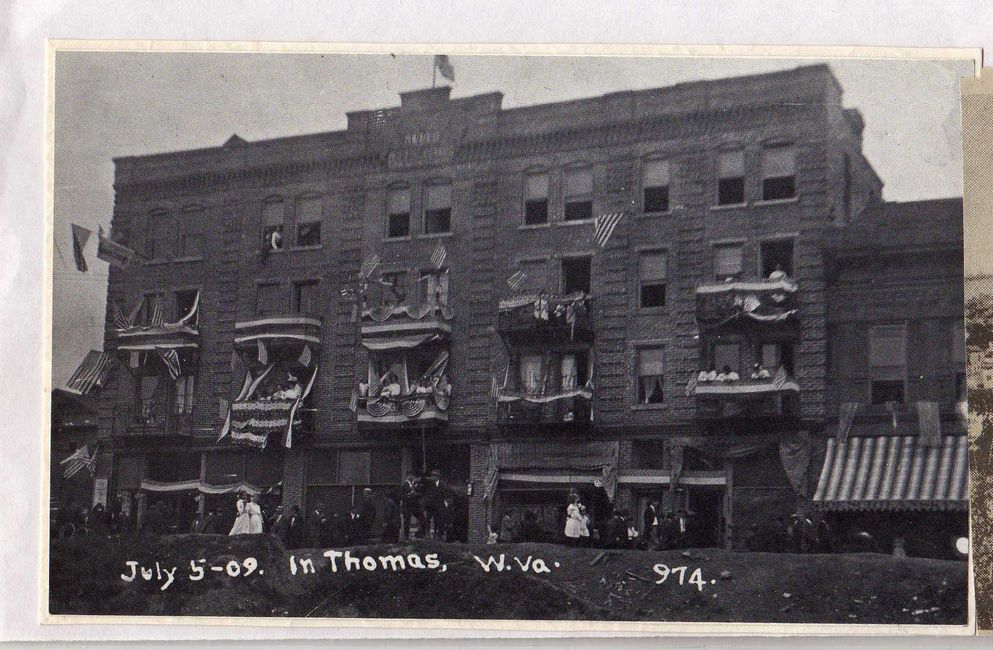
The Melting Pot of Thomas
Immigration and Ethnic Diversity
After the railroad and coal industries began operation, Thomas made a rapid transformation from isolated mountain town to small cosmopolitan city. The Davis Coal and Coke Company recruited workers from all over the world, and those workers in turn encouraged friends and family members to seek a better life in Thomas.
Rocco Benedetto (Tour No. 4) was instrumental in bringing many Italian families to Thomas. Benedetto was born in Pratola Peligna, Italy in 1864 and immigrated to the United States in 1892. Like many immigrant laborers, he had to leave his wife and family behind in Italy. He started work in the coal mines, working his way up from laborer to yard boss to coke inspector. His wife was finally able to join him in America in 1900. With his savings, Benedetto built two brick buildings and began publishing La Sentinella del West Virginia, an Italian newspaper with a statewide circulation of 3500. He also undertook a steamship ticket brokerage venture and visited Italy to recruit workers for the Davis Coal and Coke Company, arranging their travel to America.
It is estimated that as many as 18 different nationalities were represented in Thomas including Italian, Russian, Lithuanian, Polish, Austrian, Irish and Swiss. The Davis Coal and Coke Company employed interpreters including Wladyslaw Dackiewicz from Poland, who spoke 8 languages. At its peak in the 1920s, Thomas had a population of over 2000 that included families such as DeCicco, DiBacco, DePollo, DiMaio, Dilettoso, Gennantonio, Grecco, Massi, Monda, Pinto, Quattro, Udovich, Gatto, Santangelo, Schilansky, Rubenstein, Geisberger and many others. The balconies on the Benedetto Building (No. 4) and other structures, inviting storefronts and shared common areas reflect the vibrant European street life that the immigrants could not help but bring with them.
Celebrating a New Home
“The Flats” (Tour No. 4) was a bustling center of activity for Italian immigrant families. The rear piazza was a gathering place for residents as well as neighbors. Above, residents celebrate Independence Day 1909 by decorating their balconies and turning out for the parade. (Courtesy Joseph Sagace)
Though a sense of pride in family heritage persists in Thomas to this day, the residents of this city have always embraced their identity as Americans, as evidenced in the annual Fourth of July celebrations. Parades and festivities for Independence Day have been held in Thomas since at least 1908 (above). This holiday is marked by the many family and class reunions which draw far-flung former residents back for the celebration.
The Davis Coal and Coke Company posted notices in seven different languages and employed linguist Wladyslaw Dackiewicz as an interpreter. The diverse people of Thomas appear to have gotten along relatively harmoniously. (Source: West Virginia and Regional History Collection, WVU Libraries)
Most of Thomas’s immigrants were drawn by the promise of steady work in the coal mines. Though some saved money with the goal of opening their own businesses, many remained career miners. These miners and their families deserve as much credit for the growth of the Thomas Commercial Historic District as its merchants and entrepreneurs. (Courtesy R.L. Cooper)

Barney Schilansky and Victor Rubenstein were Russian Jewish immigrants and built this two-story brick structure to house their businesses and families. Their stylish building featured fine brickwork and a Victorian wooden balcony with turned spindles. It was a fine spot from which to view the 1908 July 4th festivities. (Courtesy Joseph Sagace)

The immigrant community contributed much to the development of commerce and culture in Thomas. Advertisements from the past display a variety of businesses on Front Street (East Avenue) owned by people with names of European origin, and pitch services and goods that would have been of interest to different cultural groups. This sampling includes ads for Benedetto’s steamship agency and “Foreign and Domestic Fruits” sold by Nick DiMaio (Thomas High School 1915 Yearbook Ad), Ferruso’s meat market and Venanzio DiBacco’s furniture (Thomas High School 1915 Yearbook Ad), and businesses owned by A. Dackiewicz, Bear & Gerstein, and A. Dapkus, among others (T. Nutter’s Thomas, WV, 1906.)

Download the Immigration and Ethnic Diversity Tour Sign
Ethnic Diversity (pdf)
DownloadHistoric Thomas West Virginia Walking Tour
a Project of the Tucker County Historic Landmark Commission, West Virginia Department of Arts, Culture and History, Aurora Research Associates, LLC and Digital Relativity, Inc.
www.aurora-llc.com Digitalrelativity.com
Copyright © 2020 Historic Thomas West Virginia Walking Tour - All Rights Reserved.
Powered by GoDaddy Website Builder